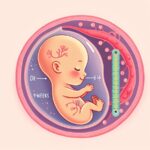Understanding ultrasound findings in week 7 of pregnancy is crucial for expecting parents. This early stage in pregnancy is often the first time you’ll catch a glimpse of your developing baby, making it an exciting yet anxious period. An ultrasound at this stage can provide invaluable information about your baby’s health and development. This guide will explore what you can expect from week 7 ultrasound findings, helping you understand the significance of each aspect.
Understanding Ultrasound Findings in Week 7
During the seventh week of pregnancy, an ultrasound is typically performed using a transvaginal approach, which provides a clearer view of the early developing fetus. This week marks important developmental milestones, such as the formation of the baby’s heart, which now beats at a regular rhythm. Understanding ultrasound findings in week 7 can help reassure parents about the pregnancy’s viability and the baby’s health.
At week 7, the ultrasound can show the gestational sac, yolk sac, and the developing embryo. The crown-rump length (CRL), which measures the length of the embryo, can be observed and used to estimate the gestational age more accurately. This is also a period when the sonographer checks for the presence of multiple pregnancies. Understanding these ultrasound findings in week 7 is essential for predicting due dates and assessing the pregnancy’s progression.
What to Expect From Your Week 7 Ultrasound
First-time parents might wonder what exactly they can expect to see during a week 7 ultrasound. Typically, the most significant finding is the heartbeat of the fetus. By this time, the heartbeat can be detected via ultrasound, appearing as a flickering in the chest area of the fetus. This is often an emotional moment for many parents, as it is a tangible sign of the new life developing inside.
Another aspect to pay attention to during the ultrasound is the measurement of the crown-rump length (CRL). This measurement is crucial as it helps in assessing the baby’s growth and determining the estimated delivery date (EDD). Understanding ultrasound findings in week 7 also involves recognizing the structure of the gestational and yolk sacs, which support the embryo’s growth.
How Ultrasound Findings in Week 7 Impact Pregnancy Care
The findings from an ultrasound at week 7 have significant implications for ongoing pregnancy care. Abnormalities detected early on can lead to early interventions, which might include dietary adjustments, lifestyle changes, or medical treatments. Understanding ultrasound findings in week 7 can also prepare parents for any potential risks and how to manage them moving forward.
For instance, if the ultrasound shows a slower than expected heart rate or an irregular gestational sac shape, your healthcare provider might schedule more frequent monitoring to ensure the pregnancy progresses healthily. This proactive approach, facilitated by understanding ultrasound findings in week 7, is crucial for ensuring both the mother’s and baby’s well-being throughout the pregnancy.
For more detailed information about what to expect in ultrasounds and pregnancy stages, exploring resources like the comprehensive guide on week 7 ultrasound findings can be incredibly beneficial. Such guides can provide deeper insights and help manage expectations for upcoming ultrasounds and pregnancy developments.
In conclusion, understanding ultrasound findings in week 7 is a pivotal part of the pregnancy journey. It not only offers the first glimpse of your developing baby but also provides essential information regarding its health and development. As you continue through your pregnancy, embracing each ultrasound with knowledge and awareness will help you navigate this beautiful journey with confidence and excitement.













